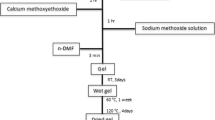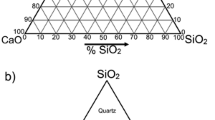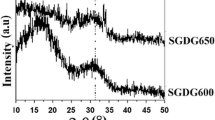Abstract
Because of the significant effect of the sol–gel method on the glass morphology at the relatively low processing temperature, in the present work, phosphate glass and glass-ceramic nanopowders with the general formula of (P2O5)55–CaO)25–(Na2O)20−x–(TiO2)x, (x = 5, 10, and 15 mol%) have been synthesized via a facile sol–gel method. For this purpose, acetone and dimethylformamide (DMF) have been used as a polar and non-protic solvent. The proportion of triethylphosphate to acetone or DMF has been selected 1:3 that they have been synthesized at 25 °C and pH = 5–6. The glass powders have been dried at 315 °C. Then, the powders synthesized by acetone have been calcined at 500 and 750 °C, and the powders synthesized by DMF have been calcined at 550, 650, and 750 °C. The glass and glass-ceramic nanopowders have been analyzed by several techniques, X-ray powder diffraction (XRD), Differential thermal analysis (STA), Fourier transform infrared spectroscopy (FT-IR), Brunauer–Emmett–Teller and Barrett–Joyner–Halenda (BET–BJH), and Scanning electron microscopy (SEM-EDS). The XRD results have been confirmed the amorphous nature of all glass samples, while after calcination, the samples have been shown the peaks assigned to β-TCP and hydroxyapatite. The SEM images have shown that the synthesized glass and glass-ceramic powders by both acetone and DMF solvents have a particle size below 50 nm and spherical morphology. Also, the glass and glass-ceramic powders, after soaking in the simulated body fluid (SBF) for 7 days, depicted the formation of hydroxyapatite and carbonated-hydroxyapatite layer on the surface of the glass and glass-ceramic powders, respectively.

Highlights
-
Use of acetone and dimethylformamide to synthesize the phosphate glass powders via Sol-gel method.
-
Producing mesoporous and nano-size glass and glass-ceramic powders with both solvent.
-
Showing the appropriate bioactivity in all glass and glass-ceramic powders.
-
No nullify the bioactivity by crystallization of glass powders, Contrary to previous studies.













Similar content being viewed by others
Change history
31 May 2022
This article has been retracted. Please see the Retraction Notice for more detail: https://doi.org/10.1007/s10971-022-05855-4
References
Solgi S, Shahrezaee M, Zamanian A et al. (2015) Sol-gel synthesis and characterization of SiO2-Cao-P2O5-SrO bioactive glass: in vitro study. Key Eng Mater 631:30–35
Solgi S, Khakbiz M, Shahrezaee M et al. (2015) Synthesis, characterization and in vitro biological evaluation of sol-gel derived Sr-containing nano bioactive glass. Silicon 9(5):535–542
Shahbazi S, Zamanian A, Pazouki M, Jafari Y (2018) Introducing an attractive method for total biomimetic creation of a synthetic biodegradable bioactive bone scaffold based on statistical experimental design. Mater Sci Eng C-Mater 86:109–120
Syed Nuzul Fadzli SA, Rosalinda S, Zainuddin F, Ismail H (2016) Synthesis of sol-gel derived glass powder and in vitro bioactivity property tested in a simulated body fluid. AIP Conf Proc 1784(1):1–5
Foroutan F, De Leeuw NH, Martin RA et al. (2015) Novel sol-gel preparation of (P2O5)0.4-(CaO)0.25-(Na2O)X-(TiO2)(0.35−X) bioresorbable glasses (X = 0.05, 0.1, and 0.15). J Sol-Gel Sci Technol 73(2):434–442
Tadjoedin ES, De Lange GL, Lyaruu DM, Kuiper L, Burger EH (2002) High concentrations of bioactive glass material (BioGran (R)) vs. autogenous bone for sinus floor elevation—histomorphometrical observations on three split-mouth clinical cases. Clin Oral Implants Res 13:428–436
Lenza RFS, Vasconcelos WL, Jones JR, Hench LL (2002) Surface-modified 3D scaffolds for tissue engineering. J Mater Sci Mater Med 13:837–842
Ahmed I, Collins CA, Lewis MP, Olsen I, Knowles JC (2004) Processing, characterization, and biocompatibility of iron-phosphate glass fibers for tissue engineering. Biomaterials 25:3223–3232
Knowles JC (2003) Phosphate-based glasses for biomedical applications. J Mater Chem 13:2395–2401
Franks K, Abrahams I, Knowles JC (2000) Development of soluble glasses for biomedical see Part I: In vitro solubility measurement. J Mater Sci Mater Med 11:609–614
Navarro M, Ginebra MP, Planell JA (2003) Cellular response to calcium phosphate glasses with controlled solubility. J Biomed Mater Res A67A:1009–1015
Kasuga T (2005) Bioactive calcium pyrophosphate glasses and glass-ceramics. Acta Biomater 1:55–64
Kasuga T (2007) Development of phosphate glass-ceramics for biomedical applications. J Ceram Soc Jpn 115:455–459
Rehr JJ, Albers RC, Zabinsky SI (1992) High-order multiple-scattering calculations of x-ray absorption fine structure. Phys Rev Lett 69:3397
Matori KA, Mohd Zaid MH, Quah HJ, Abdul Aziz SH, Abdul Wahab Z, MohdGhazali MS (2015) Studying the effect of ZnO on physical and elastic properties of (ZnO)x(P2O5)1−x glasses using nondestructive ultrasonic method. Adv Mater Sci Eng 596361:1–6
Lakhkar N, Abou Neel EA, Salih V, Knowles JC (2011) Titanium and strontium-doped phosphate glasses as vehicles for strontium ion delivery to cells. J Biomater Appl 25:877–893
Banijamali S, EftekhariYekta B, Aghaei AR (2013) Self-patterning of porosities in the CaO-Al2O3-TiO2-P2O5 glass-ceramics via ion exchange and acid leaching process. J Non-Cryst Solids 380:114–122
Islam MT, Felfel RM, Abou Neel EA, Grant DM, Ahmed I, Zakir Hossain KM (2017) Bioactive calcium phosphate-based glasses and ceramics and their biomedical applications: a review. J Tissue Eng 8:1–16
Kiani A, Hanna JV, King SP et al. (2012) Structural characterization and physical properties of P2O5-CaO-Na2O-TiO2 glasses by Fourier transform infrared, Raman and solid-state magic angle spinning nuclear magnetic resonance spectroscopies. Acta Biomater 8:333–340
Fernandes JS, Gentile P, Pires RA, Reis RL, Hatton PV (2017) Multifunctional bioactive glass and glass-ceramic biomaterials with antibacterial properties for repair and regeneration of bone tissue. Acta Biomater 1(59):2–11
Montazerian M, Zanotto ED (2016) History and trends of bioactive glass-ceramics. J Biomed Mater Res Part A 104A:1231–1249
Makita K, Nogami M, Abe Y (1997) Sol-gel synthesis of amorphous P2O5-TiO2 films and their electrical properties. J Ceram Soc Jpn 105:595–599
Li HC, Chen CZ, Hu JH, Wang DG (2013) Effect of replacing partial CaO with MgO, TiO2 or CaF2 on microstructure, mechanical properties and in vitro bioactivity of Na2O-CaO-SiO2-P2O5 glass-ceramics. J Colloid Interface Sci 405(1):296–30
Ungureanu DN, Angelescu N, Bacinschi Z, Valentina Stoian E, Rizescu CZ (2011) Thermal stability of chemically precipitated hydroxyapatite nanopowders. IJBET 5(2):57–64
Brauer DS, Rüssel C, Li W, Habelitz S (2006) Effect of degradation rates of resorbable phosphate invert glasses on in vitro osteoblast proliferation. J Biomed Mater Res Part A 77A(2):213–219
Abou Neel EA, O’ Dell LA, Smith ME, Knowles JC (2008) Processing, characterization, and biocompatibility of zinc modified metaphosphate based glasses for biomedical applications. J Mater Sci Mater Med 19(4):1669–1679
Chiriac AP, Neamtu I, Nita LE, Nistor MT (2010) Sol-gel method performed for biomedical products implementation mini-rev. Med Chem 10:990–1013
Mukundan LM, Nirmal R, Vaikkath D, Nair PD (2013) A new synthesis route to high surface area sol-gel bioactive glass through alcohol washing, a preliminary study. Biomatter 3(2):e24288
Pickup DM, Valappil SP, Moss RM et al. (2009) Preparation, structural characterization and antibacterial properties of Ga-doped sol-gel phosphate-based glass. J Mater Sci 44(7):1858–1867
Khoza PB, Moloto MJ and Sikhwivhilu LM (2012) The effect of solvents, acetone, water, and ethanol, on the morphological and optical properties of ZnO nanoparticles prepared by microwave. J Nanotechnol, Article ID 195106, p. 6. https://doi.org/10.1155/2012/195106
Sinkó K (2010) Review influence of chemical conditions on the nanoporous structure of silicate aerogels. Materials 3:704–740. https://doi.org/10.3390/ma3010704
Bakthavatchalam B, Habib K, Saidur R, Shahabuddin S, Saha BB (2020) Influence of solvents on the enhancement of thermophysical properties and stability of multi-walled carbon nanotubes nanofluid. Nanotechnology 20 31(23):235402. https://doi.org/10.1088/1361-6528/ab79ab
Foroutan F, De Leeuw NH, Martin RA et al. (2015) Sol-gel synthesis of quaternary (P2O5)55-(CaO)25-(Na2O)(20−x)-(TiO2)x bioresorbable glasses for bone tissue engineering applications (x = 0, 5, 10, or 15). Biomed Mater 10(4):045025
Pickup DM, Wetherall KM, Knowles JC, Smith ME, Newport RJ (2008) Sol-gel preparation and high-energy XRD study of (CaO)x(TiO2)0.5-x(P2O5)0.5 glasses (x = 0 and 0.25). J Mater Sci Mater Med 19:1661–1668
Soulié J, Gras P, Marsan O, Laurencin D, Rey C, Combes C (2008) Development of a new family of monolithic calcium (pyro) phosphate glasses by soft chemistry. Acta Biomater 41:320–327
Muthusamy P, Kandiah K, Manivasakan P, Venkatachalam R (2004) In vitro bioactivity and antimicrobial tuning of bioactive glass nanoparticles added with neem (Azadirachta indica) leaf powder. J Biomed Biotechnol 950691:1–10
Jones SM (2007) A method for producing gradient density aerogel. J Sol-Gel Sci Technol 44:255–258
Blumenthal NC, Cosma V (1989) Inhibition of apatite formation by titanium and vanadium ions. J Biomed Mater Res A23:13–22
Kim DS, Shin JY, Ryu BK (2017) Proton conduction in and structure of P2O5-TiO2-CaO-Na2O Sol-Gel Glasses. J Korean Phys Soc 70(12):1054–1059
Assad Maisara SM, Pat ML (2011) Synthesis and characterization of hydroxyapatite nanoparticles and β-TCP particles. 2nd Int Conf Biotechnol Food Sci 7:184–188
Davim EJC, Fernandes MHV, Santos AMR (2015) Increased surface area during sintering of calcium phosphate glass and sodium chloride mixtures. J Eur Ceram Soc 35:329–336
Pickup DM, Guerry P, Moss RM, Knowles JC, Smith ME, Newport RJ (2007) New sol-gel synthesis of a (CaO)0.3(Na2O)0.2(P2O5)0.5 bioresorbable glass and its structural characterization. J Mater Chem 17:4777–4784
Alonso LM, Garcıa-Menocal JAD, Aymerich MT et al. (2013) Calcium phosphate glasses: silanation process and effect on the bioactivity behavior of glass-PMMA composites. J Biomed Mater Res 00B:1–9
Kawachi E, Bertran C, Kubota L (1998) Interface potential of calcium phosphate in simulated body fluid. Biomaterials 19(24):2329–2333
Prabhu M, Priscilla SR, Kavitha K, Manivasakan P, Rajendran V, Kulandaivelu P (2014) In vitro bioactivity and antimicrobial tuning of bioactive glass Nanoparticles added with neem (Azadirachta indica) leaf powder. Bio-Med Res Int. Article ID 950691, 10 pages
Masel RI (1996) Principles of adsorption and reaction on solid surfaces. Wiley, New York
Sharifianjazi F, Parvina N, Tahriri M (2017) Synthesis and characteristics of sol-gel bioactive SiO2-P2O5-CaO-Ag2O glasses. J Non-Cryst Solids 476:108–113
Shankhwar N, Srinivasan A (2016) Evaluation of sol-gel based magnetic 45S5 bioglass and bioglass-ceramics containing iron oxide. Mater Sci Eng C 62:190–196
Montazerian M, EftekhariYekta B, Marghussian VK, Bellani CF, Siqueira RL, Zanotto ED (2015) Bioactivity and cell proliferation in radiopaque gel-derived CaO-P2O5-SiO2-ZrO2 glass and glass-ceramic powders. Mater Sci Eng C 55:436–447
Ionescu CT, Stevenson B, Grinsa J, Izquierdo-Barba I, Garcia A, Arcos D, Vallet-Regi M, Eden M (2015) Composition-dependent in vitro apatite formation at mesoporous bioactive glass-surfaces quantified by solid-state NMR and powder XRD. RSC Adv 5:86061–86071
Zhu B, Wang S, WangL, Yang Y, Liang J, Cao B (2017) Preparation of hydroxyapatite/tannic acid coating to enhance the corrosion resistance and cytocompatibility of AZ31 magnesium alloys. Coatings 7(7):105–115
Najafizadeh F, Seyed Sadjadi MA, Fateami SJ, KarimiMobarakeh M, MalekpourAfshar R (2016) The effects of silica and a nature polymer on the size and properties of nano-hydroxyapatite. Orient J Chem 32(3):1639–1647
Ciobanu G, Carja G, Ciobanu O, Sandu I, Sandu A (2009) SEM and EDX studies of bioactive hydroxyapatite coatings on titanium implants. Micron 40:143–146
Acknowledgements
The authors would like to acknowledge the support of the Institute of nanotechnology and biotech center of Urmia University for this research.
Author information
Authors and Affiliations
Corresponding author
Ethics declarations
Conflict of interest
The authors declare that they have no conflict of interest.
Additional information
Publisher’s note Springer Nature remains neutral with regard to jurisdictional claims in published maps and institutional affiliations.
This article has been retracted. Please see the retraction notice for more detail: https://doi.org/10.1007/s10971-022-05855-4"
About this article
Cite this article
Jalilpour, M., Rezvani, M., Hamedani, M.T. et al. RETRACTED ARTICLE: Investigation of the structural properties and bioactivity of P2O5–CaO–Na2O–TiO2 glass and glass-ceramics synthesized via a novel sol–gel method by acetone and DMF solvents. J Sol-Gel Sci Technol 97, 213–227 (2021). https://doi.org/10.1007/s10971-020-05401-0
Received:
Accepted:
Published:
Issue Date:
DOI: https://doi.org/10.1007/s10971-020-05401-0




